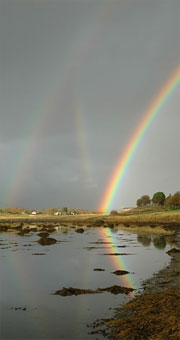The centre of a rainbow is always directly opposite the sun and therefore below the horizon.
Now imagine a low sun reflected by the mirror-like surface of a smooth lake or sea. In effect, there are then two suns and these can form two sets of rainbows. Rays from the reflected sun travel upwards and form rainbows whose centre is above the horizon. The rainbows from the two suns cross at the horizon.
The rainbows below the horizon are produced by more contorted ray paths. Sunlight from the raindrops reflects from the water (reflected bow) or is reflected before and after it reaches a raindrop (reflected-reflection bow). The ray paths are perhaps easier to remember than their names! |










